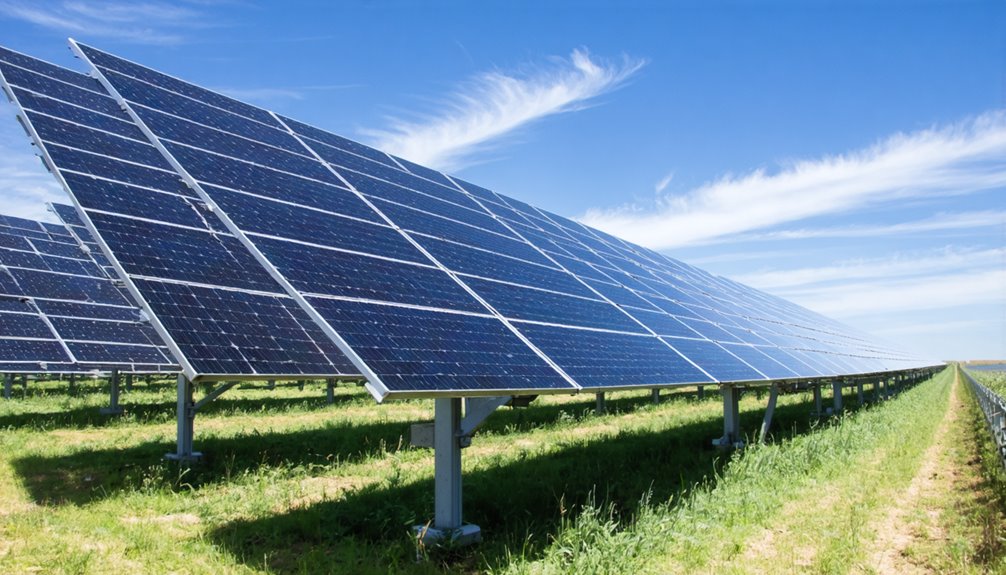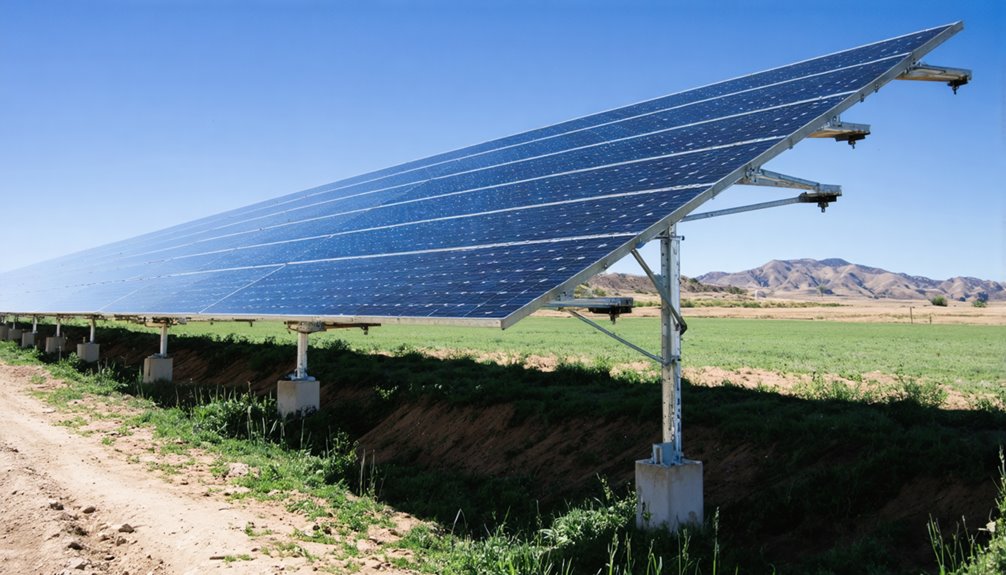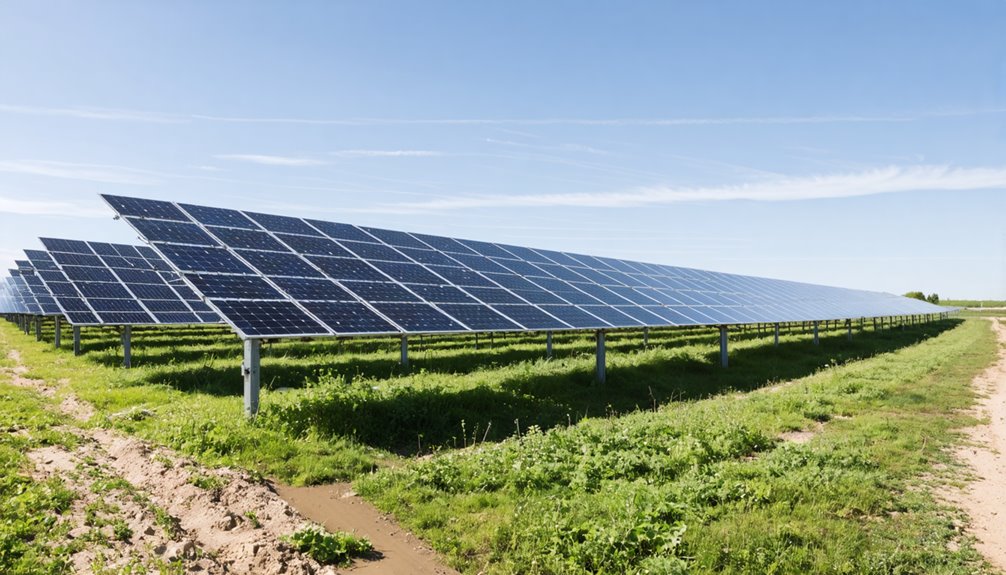Understanding wind loads on ground-mounted solar panels is essential for ensuring structural stability and optimizing energy efficiency. Wind loads exert significant pressure on the panels, affected by factors like tilt angle, geographical location, and foundation design. Inaccurate wind load calculations can lead to panel damage, misalignment, and financial losses due to repairs and system downtime. By considering these aspects and planning strategically, you can enhance durability and efficiency, minimizing risks during high winds while ensuring reliable solar performance. Explore further for thorough insights.
The Basics of Wind Load and Its Impact on Solar Installations
Understanding wind load is essential when considering solar panel installations, as it refers to the force that wind exerts on both the panels and their supporting structures, directly impacting their ability to withstand such pressures while maintaining safety. You must guarantee that these installations can manage wind loads effectively to maintain structural stability. The tilt angle of solar panels greatly influences wind pressures, with different configurations leading to variations in aerodynamics and pressure distribution. On flat terrains like Cordova, Memphis, where there’s a lack of natural windbreaks, these systems are particularly vulnerable to increased wind pressures. As a result, precise wind load calculations, often guided by ASCE 7-16 standards, are critical to sustaining the structural integrity of solar panels throughout their lifespan, preventing potential hazards and guaranteeing operational safety.
Key Variables Influencing Wind Loads on Solar Structures
Having grasped the basics of wind load and its impact on solar installations, it’s vital to reflect on the key variables that influence these loads on solar structures. Geographical location plays a significant role, with coastal and mountainous areas experiencing varying wind forces. Structural height also affects exposure; taller systems face greater forces than ground-mount installations. Furthermore, tilt angle impacts airflow; steeper angles increase resistance, requiring precise engineering to prevent uplift. Additionally, soil type and foundation design are vital, as weaker soils may necessitate stronger anchoring. Surrounding features like obstacles or vegetation can modify wind paths, so it’s important to take them into account in your assessments.
| Variable | Influence | Mitigation |
|---|---|---|
| Geographical Location | Varies wind forces | Site-specific planning |
| Tilt Angle | Affects resistance | Adjustable engineering |
| Structural Height | Increases exposure | Lower mount considerations |
Understanding wind loads is fundamental to selecting appropriate foundation strategies and ensuring long-term stability.
Calculation Methodologies for Wind Loads Using ASCE 7-16 Standards
In calculating wind loads for solar panels, ASCE 7-16 provides systematic methodologies utilizing wind load formulas and velocity pressure calculations, such as the key equation \({q}_{h} = 0.00256{K}_{z}{K}_{zt}{K}_{d}{K}_{e}V^2\), which incorporates essential coefficients for accuracy. Understanding the basic wind speed specific to your location, like the 100 mph for Cordova, Memphis, is vital as it underpins the velocity pressure calculations. Additionally, the Risk Category of the structure influences the load calculations, ensuring that panels meet critical safety and performance standards.
Wind Load Formulas
Accurately calculating wind loads on solar panels is essential for ensuring structural integrity, particularly when using the ASCE 7-16 standards, which provide a thorough framework for such calculations. Understanding the Wind Load on your mounting structures begins with Chapter 27 of these standards, offering procedural methods and necessary formulas. For panels with tilt angles of 45° or less, use the formula \(p = {q}_{h}G{C}_{N}\); for angles above 45°, apply \(p = {q}_{h}G{C}_{f}\). These equations consider different wind conditions, effectively incorporating pressure dynamics. The velocity pressure \(q_h\), calculated through various coefficients—such as height exposure and topographic factors—is pivotal. Additionally, net pressure coefficients vary with panel tilt and wind direction, influencing the loads felt by your structure.
Velocity Pressure Calculation
Understanding the calculation of velocity pressure, a key component in determining wind loads as per ASCE 7-16 standards, involves grasping the interrelationship of several critical coefficients and environmental factors. You calculate velocity pressure (\(q_h\)) using the formula \(q_h = 0.00256K_zK_{zt}K_dK_eV^2\), with \(V\) representing basic wind speeds. For a location like 395 Rocky Point Rd, Cordova, Memphis, with wind speeds of 100 mph and mounting systems at 8.33 ft, you achieve a \(q_h\) of 18.256 psf. This involves parameters like \(K_z = 0.85\), \(K_{zt} = 1.0\), \(K_d = 0.85\), and \(K_e = 0.987\). As mounting systems include solar panel tilt angles, wind loads are affected, necessitating precise velocity pressure calculations to guarantee structural safety.
Risk Category Factors
When evaluating wind load calculations for solar panels, considering the Risk Category is essential, as these categories dictate design requirements that account for a structure’s potential for societal risk and property damage during extreme wind events. Typically, ground-mounted solar panel installations fall under Risk Category I, as identified in ASCE 7-16 Table 1.5-1, reflecting low potential for damage and minimal risk to human life. In calculating wind loads, specific parameters such as basic wind speed (100 mph in Cordova, Memphis), exposure category, and building height are pivotal, influencing both wind pressure and energy output. The tilt angle, velocity pressure coefficients \( K_z \) and \( K_e \) (0.987), and gust effect factor \( G \) (0.85), collaboratively inform design pressures, enhancing system resilience against wind-induced forces.
Effects of Installation Angle and Elevation on Wind Pressure

Although installation angle and elevation aren’t the only factors influencing wind pressure on solar panels, they play an essential role in determining the overall wind load. The panel tilt, especially at angles such as 30°, alters wind load calculations due to varying pressure coefficients, as observed in standard solar mounting configurations. Lower angles generally provide more resistance against high winds, whereas increased elevation modifies the velocity pressure, exemplified by a virtually 18.256 psf calculation at an 8.33 ft mounting height given a 100 mph wind speed in Cordova, Memphis. Additionally, the windward and leeward pressures, both calculated as -1.8 according to ASCE 7-16 data, illustrate how critical the positioning is, directly impacting the structural assessments and ensuring the solar panels withstand wind uplift effectively.
Structural Risks Associated With Improper Wind Load Calculations
Inadequate wind load calculations pose significant structural risks to solar panel installations, often leading to panels detaching or becoming misaligned during even moderate storms, which results in costly repairs and system downtime. This is especially true when planners underestimate the impact of layout choices that leverage ground-mounted advantages like siting flexibility. When wind load calculations are neglected, particularly in ground-mounted solar installations in open areas, structural failures become more prevalent. These systems are prone to wind uplift and lateral forces that can severely affect foundational integrity. By ignoring factors like tilt angle and geographical location, the wind pressure on panels increases, causing frame bending and misalignment over time. Additionally, excessive wind loads introduce vibrations and instability, accelerating wear and reducing energy efficiency. Incorrect assessments lead to financial losses and impact your solar installation’s return on investment.
Engineering Solutions for Enhancing Wind Resistance in Solar Panels
Addressing the structural vulnerabilities of solar panels due to inadequate wind load calculations calls for effective engineering solutions that bolster wind resistance. Using high-strength, galvanized steel frames enhances the structural integrity of solar panels, providing a robust defense against varying wind loads. Engineering solutions tailor customized mounting systems to local wind profiles, guaranteeing that panels endure high regional wind speeds. Adjustable tilt angles in ground-mounted systems not only optimize sunlight exposure but also reduce wind resistance, minimizing potential wind loads on panels. Implementing advanced foundation solutions, like deep anchoring systems, is essential for stability during high wind events. Regular assessments following ASCE 7-16 standards validate these solutions’ effectiveness, ensuring the solar installations withstand wind-related challenges successfully.
Best Practices for Installing Ground-Mounted Solar Panels in High-Wind Areas

When installing ground-mounted solar panels in high-wind areas, it’s important to conduct a thorough site assessment that meticulously evaluates soil composition, prevailing wind patterns, and local topography to inform the design of appropriate foundation systems. Utilizing high-strength, galvanized steel materials in the mounting structures enhances durability, increasing high-wind resistance and ensuring your solar panels remain stable during gusty conditions. Engaging custom-engineered racking systems tailored for high-wind resistance also prevents misalignments or structural failures. It’s critical to employ deep anchoring solutions suited to local wind speed classifications to maintain the integrity of the installation.
| Best Practices | Benefits |
|---|---|
| High-Strength Materials | Enhanced Durability |
| Custom Racking Systems | Structural Stability |
| Regular Inspections | Early Detection of Issues |
Scheduling regular inspections is important for detecting any wear or damage early, safeguarding your setup.
Designs should emphasize wind-resilient performance, leveraging tall structural durability and high-wind resistance in practical installations.
Evaluating and Choosing Reliable Solar Mounting Systems for Windy Environments
When choosing solar mounting systems for windy environments, you should prioritize designs that address critical system features such as high wind resistance, employing materials like high-tensile strength galvanized steel to guarantee durability. It is crucial to incorporate foundation solutions that are deep-anchored to withstand local wind pressures effectively, thereby minimizing the risk of structural failure during severe weather events. Regular maintenance protocols and site-specific wind load analyses are also important for early detection of wind-related issues and to verify that your installations are compliant with safety standards and local building codes.
Critical System Design Factors
Evaluating and choosing reliable solar mounting systems for windy environments requires a meticulous approach to system design, factoring in site-specific wind load analyses that incorporate basic wind speeds, terrain categories, and building heights to align with ASCE 7-16 standards. This guarantees your solar installation can withstand local wind pressures and maintain structural integrity. High-strength materials, such as cold roll-formed galvanized steel, are crucial for enhancing durability against these wind loads. Incorporating adjustable tilt angles maximizes exposure while minimizing wind resistance, thereby supporting stability. Furthermore, selecting proper foundation systems tailored to specific wind conditions is essential to prevent module detachment or frame bending. Regular inspections and maintenance further confirm that any potential wind-related issues are promptly identified and resolved for peak performance.
Durable Material Selection Criteria
Why is it essential to prioritize material strength and durability when selecting solar mounting systems for windy environments? Ensuring durability in these systems is vital as they face substantial wind loads. High-strength, galvanized steel materials are highly recommended for their superior corrosion resistance and longevity, making them ideal for withstanding harsh conditions. Evaluate the tensile strength of materials; those with higher tensile strength perform better under stress. Opt for mounting systems with reinforced frames and deep anchoring methods, effectively reducing structural failure risk due to wind-induced forces. Additionally, consider the weight and design, as lightweight materials with aerodynamic shapes minimize wind resistance while maintaining structural integrity. Regular inspections mitigate weathering effects, ensuring maximum performance and safety.
Regular Maintenance Protocols
In windy environments, implementing regular maintenance protocols for solar mounting systems is essential to maintain their structural integrity and operational efficiency. Start by inspecting your solar panels bi-annually, focusing on signs of wear, misalignment, or loosening bolts, as these can compromise the system under heavy wind loads on solar installations. Systems are often constructed using high-strength, galvanized steel to withstand severe weather, ensuring longevity in such regions. Adjustable tilt mechanisms enhance stability and optimize sunlight exposure. Employing deep anchoring foundation systems can offer critical support to withstand wind forces. Regularly assess local wind patterns and consider installing wind barriers or shelters to mitigate gust impacts, thereby boosting the reliability and lifespan of your solar mounting system in windy conditions.
Conclusion
Understanding wind loads is essential for ensuring the structural integrity and long-term performance of ground-mounted solar panel installations. Proper assessment of factors including installation angle, elevation, and local wind conditions, combined with adherence to ASCE 7-16 standards for wind load calculations, forms the foundation for resilient solar structures. The implementation of robust engineering solutions and selection of appropriate mounting systems are critical for mitigating wind-related risks and maintaining system efficiency under adverse weather conditions. Solocity Global serves as a trusted exporter of solar panel mounting systems, providing high-quality, standards-compliant mounting solutions to clients across global markets.


